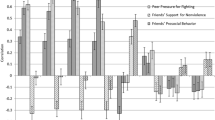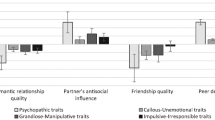Abstract
The relationship between behavior problems and adolescent peer relations was examined in 30 black male adolescents divided into three equal-sized groups on the basis of individual psychosocial functioning (conduct-disordered, anxious-withdrawn, well-adjusted). Groups were matched on age, IQ, and father absence. An observational method was used to evaluate dominance, conflict, affect, and social competence manifested with a friend and with a well-adjusted stranger. Conduct-disordered and anxious-withdrawn adolescents displayed less social competence and less positive affect than well-adjusted adolescents when interacting with both friends and strangers. Anxious-withdrawn adolescents evidenced more personal apprehension than their well-adjusted counterparts. All groups showed greater leadership ability, talked more, and showed less personal apprehension with friends than with strangers. The findings support the role of peer relations in the maintenance and exacerbation of adolescent psychosocial difficulties.
Similar content being viewed by others
References
Asher, S. R., & Renshaw, P. D. (1981). Children without friends: Social knowledge and social skill training. In S. R. Asher & J. M. Gottman (Eds.),The development of children's friendships (pp. 273–298). New York: Cambridge University Press.
Berndt, T. J. (1979). Developmental changes in conformity to peers and parents.Developmental Psychology, 15, 608–616.
Blos, P. (1962).On adolescence: A psychological interpretation. Glencoe, Illinois: Free Press.
Cowen, E. L., Pederson, A., Babigian, H., Izzo, L. D., & Trost, M. A. (1973). Long-term follow-up of early detected vulnerable children.Journal of Consulting and Clinical Psychology, 41, 438–446.
Diaz, R. M., & Berndt, T. J. (1982). Children's knowledge of a best friend: Fact of fancy?Developmental Psychology, 18, 787–794.
Douvan, E., & Adelson, J. (1966).The adolescent experience. New York: Wiley.
Erickson, E. (1968).Identity, youth, and crisis. New York: Norton.
Farina, A. (1960). Patterns of role dominance and conflict in parents of schizophrenic patients.Journal of Abnormal and Social Psychology, 61, 31–38.
Foot, H. C., Chapman, A. J., & Smith, J. R. (1977). Friendship and social responsiveness in boys and girls.Journal of Personality and Social Psychology, 35, 401–411.
Freedman, B. J., Rosenthal, L., Donahoe, C. P., Schlundt, D. O., & McFall, R. M. (1978). A social-behavioral analysis of skill deficits in delinquent and nondeliquent adolescent boys.Journal of Consulting and Clinical Psychology, 46, 1448–1462.
Gottman, J. M. (1977). Toward a definition of social isolation in children.Child Development, 48, 513–517.
Gottman, J. M. (1983). How children become friends.Monographs of the Society for Research in Child Development, 48(2, Serial No. 201).
Hanson, C. L., Henggeler, S. W., Haefele, W. F., & Rodick, J. D. (1984). Demographic, individual, and family relationship correlates of serious and repeated crime among adolescents and their siblings.Journal of Consulting and Clinical Psychology, 52, 528–538.
Hetherington, E. M., Stouwie, R. I., & Ridberg, E. H. (1971). Patterns of family interaction and child rearing attitudes related to three dimensions of juvenile delinquency.Journal of Abnormal Psychology, 78, 160–176.
Howes, C. (1983). Patterns of friendship.Child Development, 54, 1041–1053.
Jacob, T. (1974). Patterns of family conflict and dominance as a function of child age and social class.Developmental Psychology, 10, 1–12.
Jones, F. H. (1974). A 4-year follow-up of vulnerable adolescents.Journal of Nervous and Mental Disease, 159, 20–39.
Kohn, M., & Parnes, B. (1974). Social interaction in the classroom: A comparison of apathetic-withdrawn and angry-defiant children.Journal of Genetic Psychology, 125, 165–175.
Kohn, M., & Rosman, B. L. (1972). A social competence scale and symptom checklist for the preschool child: Factor dimensions, their cross-instrument generality, and longitudinal persistence.Developmental Psychology, 6, 430–444.
Mishler, E. G., & Waxler, N. E. (1968).Family processes and schizophrenia: Theory and selected experimental studies. New York: Science House.
Newcomb, A. F., & Brady, J. E. (1982). Mutuality in boys' friendship relations.Child Development, 53, 392–395.
Newcomb, A. F., Brady, J. E., & Hartup, W. W. (1979). Friendship and incentive condition as determinants of children's task-oriented social behavior.Child Development, 50, 878–881.
Newman, B., & Newman, P. (1975).Development through life: A psychosocial approach. Homewood, Illinois: Dorsey Press.
Offer, D. (1969).The psychological world of the teenager. New York: Basic Books.
Panella, D., Cooper, P. F., & Henggeler, S. W. (1982). Peer relations in adolescence. In S. W. Henggeler (Ed.),Delinquency and adolescent psychopathology: A family-ecological systems approach (pp. 139–161). Littleton, Massachusetts: Wright-PSG.
Quay, H. C. (1977). Measuring dimensions of deviant behavior: The Behavior Problem Checklist,Journal of Abnormal Child Psychology, 5, 277–289.
Quay, H. C. (1979). Classification. In H. C. Quay & J. S. Werry (Eds.),Psychopathological disorders of childhood (pp. 1–42). New York: Wiley.
Quay, H. C., & Peterson, D. R. (1975).Manual for the Behavior Problem Checklist. Unpublished manuscript, University of Miami.
Roff, J. D., & Wirt, R. D. (1984). Childhood aggression and social adjustment as antecedents of delinquency.Journal of Abnormal Child Psychology, 12, 111–126.
Savin-Williams, R. C. (1979). Dominance hierarchies in groups of early adolescents.Child Development, 50, 923–935.
See, J. J., & Miller, K. S. (1973). Mental health. In K. S. Miller & R. M. Dreger (Eds.),Comparative studies of blacks and whites in the United States (pp. 447–466). New York: Seminar Press.
Siman, M. L. (1977). Application of a new model of peer group influences to naturally existing adolescent friendship groups.Child Development, 48, 270–274.
Sorensen, R. (1973).Adolescent sexuality in contemporary America. New York: World Publishing.
Tao Hunter, F., & Youniss, J. (1982). Changes in functions of three relations during adolescence.Developmental Psychology, 18, 806–811.
Wechsler, D. (1955).Manual for the Wechsler Adult Intelligence Scale. New York: Psychological Corporation.
Whalen, C. K., Henker, B., Collins, B. E., McAuliffe, S., & Vaux, A. (1979). Peer interaction in a structured communication task: Comparisons of normal and hyperactive boys and of Ritalin and placebo effects.Child Development, 50, 388–401.
Author information
Authors and Affiliations
Additional information
This research was supported by funding to the Department of Psychology at Memphis State University granted through the Centers of Excellence Program of the State of Tennessee. This article is based on a master's thesis submitted by the first author to the Department of Psychology at Memphis State University.
Rights and permissions
About this article
Cite this article
Panella, D., Henggeler, S.W. Peer interactions of conduct-disordered, anxious-withdrawn, and well-adjusted black adolescents. J Abnorm Child Psychol 14, 1–12 (1986). https://doi.org/10.1007/BF00917217
Revised:
Issue Date:
DOI: https://doi.org/10.1007/BF00917217




